Student aid plays an important role in ensuring both educational and social equality; it also contributes to poverty alleviation and realizing the sharing development.
The year 2016 saw China continue to improve its student aid policies and increase related funds as a result of the combined efforts of financial and education ministries, local governments and schools.
The improvements have helped students from impoverished backgrounds gain admission to schools and complete their studies.

National student aid policies further improved
1.1 Policy improvements
The ministries of finance and education released a document in August 2016 stating that from the autumn semester of 2016, registered poverty-stricken students at public high schools, along with other needy students, should be granted exemption from paying tuition and related educational fees.
Sixteen provincial-level regions issued aid policies targeting registered students from impoverished families. In the Guangxi Zhuang autonomous region, such students can enjoy 15 years of free education, while Guizhou province added specific poverty alleviation projects for the benefit of impoverished students attending high schools, secondary vocational schools and institutions of higher education, providing subsidies for tuition, accommodation fees and textbook fees. Shandong province released four aid policies for registered poor students, ranging from preschool education to higher education; Hainan province increased aid standards for registered poor students that are not in compulsory education (compulsory education is from grades one to nine).
The tuition exemption eligibility range for secondary vocational schools was expanded in provincial-level regions such as Fujian, Shandong and Shanxi. By the end of 2016, 22 provincial-level regions had achieved tuition exemption for all secondary vocational school students and 28 such areas had introduced tuition exemption policies for students majoring in traditional Chinese opera performance.
1.2 Policy system improved
The national student financial aid system covers all educational stages, both public and private schools and all students from impoverished families.
Local governments offer financial support to children from poor families, orphans and children with disabilities in government-funded kindergarten education.
Students in compulsory education receive free, government-funded education and textbooks. Boarding students from impoverished families are also eligible to receive subsidies.
Students in secondary vocational education generally receive grants supplemented with additional aid via workplace internships which are funded by schools and social sponsors.
High school students generally receive national grants, with students from poor families receiving exemption from tuition fees. Supplementary funding is provided by local government projects and social donations.
For undergraduate students, a multifaceted aid policy system was established. The system includes national scholarships, grants and student loans, tuition and loan compensation for grassroots employment, subsidies for military service, school aid, work-study programs, free education for students enrolled in teaching programs, tuition subsidies for retired soldiers, subsidies for students from impoverished families, meal subsidies, tuition reduction and exemption and a “green channel” allowing freshmen to register at colleges or universities even when they are unable to pay their tuition fees in full.
For postgraduate students, student aid comprises national scholarships for academic excellence, grants, allowances for graduate assistantship, student loans, tuition and loan compensation for grassroots employment, subsidies for enlisted military service, school aid and the “green channel” as detailed above.
Student aid made more meaningful
2.1 Aid orientation has shifted from paying students’ study and living costs to helping them develop a greater sense of autonomy and independence
Promoted by the Ministry of Education, schools in different regions began to place a greater emphasis on helping students to progress in 2016 while still implementing student aid policies. The schools attached importance to fostering an innovative spirit and practical abilities among aid-receiving students. They also inculcated an ever greater sense of social responsibility and integrity.
Focusing on the theme of “funding students and educating them”, the schools explored diverse practices. They organized activities for students, themed “integrity education”, activities that publicized models among excellent students, activities that collect and evaluate students’ themed articles, speaking competitions, activities that evaluate short films, public services, volunteer services, skills training, overseas study and activities for improving students’ overall employability.
The schools aimed to set up a long-term mechanism involving material aid, moral inculcation, ability promotion, spiritual stimulation and standard management.
2.2 Precise aid fully advanced
The Ministry of Education required schools from different regions to fully, accurately and rapidly implement national student aid policies in 2016.
The schools explored new thinking patterns and methods for implementing precise aid measures. They referred to educational statistics and considered factors such as regional economic development and the proportion of students in difficulties. They focused on under developed areas and regions with many poor students when it came to allocating their aid fund budgets.
The schools also strengthened cooperation with disabled people’s federations as well as poverty alleviation and civil affairs departments, and they cooperated further to finalize their aid objectives.
The schools also worked out how to finalize their aid objectives and funding standards by combining big data-based analysis and student feedback. They granted funds according to students’ poverty levels and increased help was given to registered students from poor families, as well as orphaned and disabled students.
3. Funding of student aid continues to grow
3.1 The total funding surpassed 160 billion yuan ($23.2 billion)
In 2016, more than 91.26 million students in receipt of preschool education, compulsory education, secondary vocational education, high school education and higher education, got subsidies, marking an increase of around 6.93 million year-on-year.
A total of almost 168 billion yuan was spent on subsidizing needy students in 2016, increasing 12.85 billion yuan on the previous year. The year-on-year growth is 8.24 percent.
The amount of funding for student aid has maintained a rapid growth rate for the past decade, ever since the government started building the national student financial aid system in 2007.
A total of nearly 6.82 billion yuan was invested to subsidize more than 6.19 million preschool children. About 16.51 billion yuan was allocated to boarding students in compulsory education, supporting around 15.64 million students.
Over 15 million students at secondary vocational schools received financial support totaling more than 33.21 billion yuan. About 11.58 million high school students received financial subsidies, the sum of which reached 16.75 billion yuan, marking a year-on-year increase of about 2.82 billion yuan, or 20.26 percent. Nearly 42.82 million college and university students were supported by subsidies totaling more than 95.58 billion yuan, an increase of some 10.79 billion yuan, 12.72 percent, on the previous year.
3.2 Free textbooks costing 20.4 billion yuan
In 2016, 16.74 billion yuan was provided by financial departments at all levels for the national free textbook fund, benefiting 128 million students in compulsory education. About 10.98 billion yuan came from the central government and some 5.76 billion yuan was from local governments.
Local financial departments provided around 3.73 billion yuan to the local free textbook fund, benefiting 68.27 million students in compulsory education.
3.3 A total of 25.1 billion yuan provided for nutrition programs
In 2016, student nutrition programs were introduced in about 85,000 schools, benefiting about 21.17 million rural students in compulsory education. More than 18.93 billion yuan of central government funding was provided to the nutrition programs. Pilot programs were developed in 807 counties in 26 provincial-level regions, covering about 48,000 schools, supporting some 13.12 million students. Nearly 6.15 billion yuan was provided by local government financial departments.
4. Government funds played a dominant role in enhancing national student financial aid.
4.1 Governments spent more than 110 billion yuan on student financial aid, an increase of 5.45 percent on 2015.
In 2016, government funding provided about 110.92 billion yuan for student financial aid, an increase of more than 5.73 billion yuan, or 5.45 percent, on 2015. About 57.92 billion yuan came from the central government, up about 1.98 billion yuan, or 3.54 percent, year-on-year. Nearly 53 billion yuan was from local governments, an increase of more than 3.75 billion yuan, or 7.62 percent, year-on-year.
Government funding was the main source of national student subsidies, accounting for 65.68 percent of the total. Funds from the central government contributed 34.3 percent while 31.38 percent was from local governments.
A total of 6.62 billion yuan from government funding was spent subsidizing preschool education, accounting for 97.1 percent of the total funding for this education stage. Subsidies for school boarders in compulsory education all came from government funding.
Governments earmarked 25.64 billion yuan for secondary vocational schools, accounting for 77.2 percent of the total subsidies for secondary vocational education. More than 15.21 billion yuan provided by government funding made up 90.82 percent of subsidies for high school students. Some 46.94 billion yuan, or 49.1 percent of the sum of subsidies for colleges and universities, came from government funding.
4.2 National student loans for college and university students amounted to 26.3 billion yuan, up 19.72 percent from 2015
National student loans for higher education reached about 26.32 billion yuan, up more than 4.33 billion yuan, or 19.72 percent, on 2015. The loans are an important aspect of higher education subsidies, making up 27.54 percent of the total.
4.3 Schools provided subsidies worth nearly 22 billion yuan, a year-onyear rise of 13.14 percent
Last year, about 21.92 billion yuan of subsidies came from the schools’ revenue, a year-on-year increase of 2.08 billion yuan, or 13.14 percent, accounting for 12.98 percent of the total funding.
4.4 Social funds reached 9.7 billion yuan
In 2016, donations from enterprises, institutions, social groups and individuals amounted to about 9.71 billion yuan, more or less unchanged from the previous year and accounting for 5.75 percent of the total funding.
5. All policies were implemented effectively
5.1 Subsidies for preschool children
In 2016, nearly 6.2 million children in kindergartens received financial support from governments at all levels, individual kindergartens and charitable donations.
More than 5.85 million children were supported by governments. About 279,000 children were supported by kindergartens and 60,600 children received social funding and charitable donations.
The sum of all subsidies reached nearly 6.9 billion yuan. About 6.6 billion yuan came from governments, 160 million yuan came from kindergartens and nearly 38 million yuan came from charitable donations and social funds.
1) Aid from the government
In 2016, governments at all levels helped more than 5.85 million children-14.13 percent of all children in kindergartens nationwide-with financial subsidies. In western China, about 3.44 million children received financial aid, accounting for 27.62 percent of all enrolled children.
In central China, more than 1.17 million children, roughly 7.68 percent, received financial aid. In eastern China, more than 1.23 million children received financial aid, or 9.07 percent of all enrolled children.
Governments at all levels provided financial aid of 6.62 billion yuan.
About 1.5 billion yuan came from the central government to support kindergartens nationwide, accounting for 22.66 percent of the total; nearly 3 billion yuan, or 45.26 percent, came from provincial-level governments; 413 million yuan, or 6.24 percent, from city-level governments; and 1.71 billion yuan, or 25.84 percent, from county-level governments.
By region, nearly 3.9 billion yuan, or 58.82 percent, was spent in western China; more than 1 billion yuan, or 15.57 percent, in central China; and about 1.7 billion yuan, or 25.61 percent, was allocated in eastern China.
2) Aid from kindergartens
In 2016, 279,000 children in kindergartens received financial support from kindergartens’ revenues. Of these children, nearly 126,000 were from western China; 94,600 from central China; and 58,500 from eastern China.
Related subsidies amounted to 160 million yuan, with 56 million yuan spent in western China, 40 million yuan in central China and 64 million yuan in eastern China.
3) Aid from wider society
In 2016, about 60,000 children received aid from wider society. About 15,800 of these children were from western China, 22,700 from central China and 22,100 from eastern China.
Related subsidies amounted to nearly 38 million yuan. Nearly 5.9 million yuan was spent in western China, 14.36 million yuan in central China and 17.66 million yuan in eastern China.
5.2 Subsidies for students in compulsory education
In 2016, about 128 million students at the compulsory education stage were provided with free textbooks. Of these students, more than 68 million benefited from the free textbook policy supported by local governments and 15.64 million from impoverished families received subsidies for their living expenses.
Governments at all levels provided about 16.74 billion yuan for free textbooks and dictionaries.
More than 10.98 billion yuan was provided by the central finance department and 3.73 billion yuan by local finance departments.
About 16.51 billion yuan was spent on subsidizing boarding students from impoverished families. Of this sum, more than 7.1 billion yuan was from the central budget.
1) Free textbooks provided by the central government
In 2016, about 128 million students at the compulsory education stage received free textbooks, accounting for 91.87 percent of the total. By region, 36.08 million students, or 88.6 percent, in western China benefited from the free textbook policy; the figure was 48.41 million, or 89.14 percent, in central China; and in eastern China, it was 43.68 million, 98.18 percent.
Finance departments at all levels spent a total of 16.74 billion yuan on providing free textbooks.
About 10.98 billion yuan, or 65.61 percent, came from the central government; about 3.9 billion yuan, or 23.27 percent, was from provincial-level governments; about 257 million yuan, or 1.54 percent, was from city-level governments; and about 1.6 billion yuan, or 9.58 percent, was from county-level governments.
By region, about 4.37 billion yuan, or 26.09 percent, was spent in western China. About 5.28 billion yuan, or 31.51 percent, was spent in central China.
About 7.1 billion yuan, or 42.4 percent, was spent in eastern China.
2) Free textbooks provided by local governments
In 2016, about 68.27 million students received free textbooks provided by local governments, accounting for 48.93 percent of the total number.
Of these students, about 19.92 million were in western China, accounting for 48.91 percent. About 25.67 million were in central China, accounting for 47.27 percent. And 22.68 million students were in eastern China, accounting for 50.97 percent.
More than 3.7 billion yuan was provided by local governments to support the free textbook policy. About 835 million yuan came from governments in western China, 22.4 percent of the total; 855 million yuan came from governments in central China, 22.94 percent; and 2.04 billion came from governments in eastern China, 54.66 percent.
3) Living allowances for boarding students
In 2016, more than 15.63 million boarding students from impoverished families benefited from the living allowance policy, accounting for 53.64 percent of the total number of boarding students nationwide. Of these students, more than 10.1 million were in western China, accounting for 79.12 percent of all local boarding students. About 3.75 million were in central China, accounting for 31.22 percent, and about 1.78 million were in eastern China, making up 40.74 percent.
More than 16.5 billion yuan was provided by governments at all levels to support students. About 7.16 billion yuan came from the central government, accounting for 43.37 percent of the total. About 6.16 billion yuan, or 37.32 percent, was provided by provincial-level governments. About 663 million yuan, or 4.02 percent, came from city-level governments. About 2.53 billion yuan, or 15.29 percent, came from county-level governments.
The amount of money spent on subsidizing living expenses for boarding students in western, central and eastern China was 11.09 billion yuan or 67.14 percent, 4.22 billion yuan or 25.56 percent and 1.21 billion yuan or 7.3 percent respectively.
5.3 Secondary vocational education
In 2016, about 33.21 billion yuan was spent on subsidizing 15.02 million students studying at secondary vocational schools.
More than 10 million of these students benefited from national tuition exemptions totaling 20.01 billion yuan; 2.49 million benefited from national grants totaling 4.98 billion yuan; local governments put in 645 million yuan to help 556,700 students; schools provided 358 million yuan for 550,700 people; wider social aid totaled 109 million yuan and supported 39,900 students; and about 1.38 million students at secondary vocational schools received part of their tuition through workplace internships, amounting to 7.11 billion yuan.
1) National tuition exemption
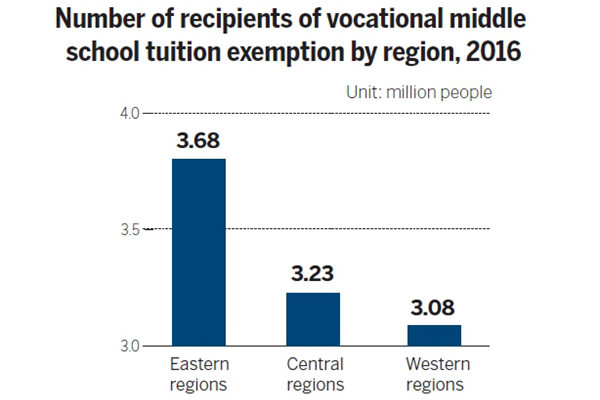
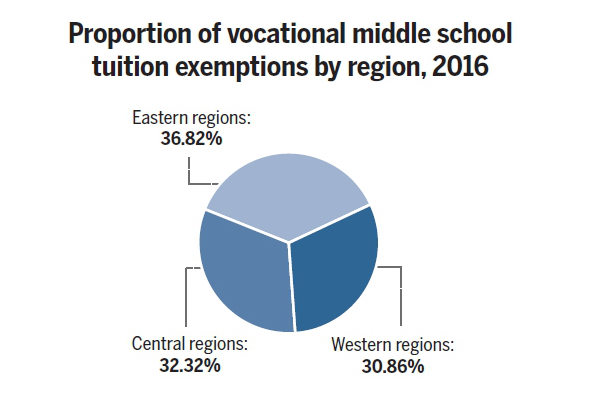
In 2016, more than 10 million students at secondary vocational schools had their tuition waived thanks to the national tuition exemption policy. About 3.09 million students were in western China, 30.86 percent of the total; 3.23 million students were in central China, about 32.32 percent; and 3.68 million were in eastern China, about 36.83 percent.
The central and local governments spent a total of 20.01 billion yuan on subsidizing tuition exemptions, about 60.25 percent of the total subsidy for secondary vocational education. About 10.73 billion yuan came from central government financial support, accounting for 53.62 percent of the total amount of subsidy for tuition exemption. The remaining 9.28 billion yuan, or 46.38 percent, was from local governments.
By region, about 6.18 billion yuan, or 30.86 percent of total tuition exemption funding, was spent in western China. About 6.47 billion yuan, or 32.32 percent, was spent in central China, and 7.37 billion yuan, or 36.82 percent, was spent in eastern China.
2) National grants
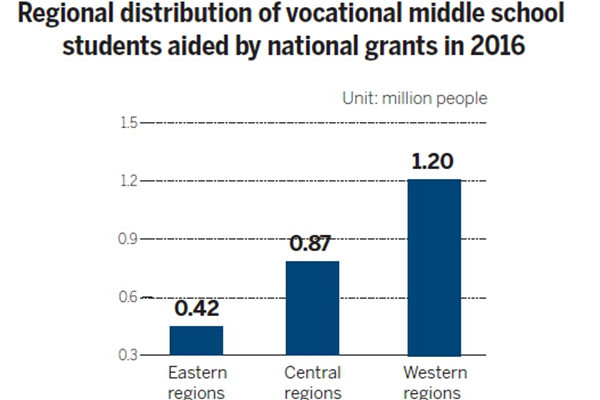

In 2016, about 2.49 million students at secondary vocational schools received national grants. About 1.2 million, or 48.34 percent, were in western China. About 870,500, or 34.93 percent, were in central China, and about 417,000, or 16.73 percent, were in eastern China.
Governments at all levels spent about 4.98 billion yuan providing national grants, which made up 15.01 percent of all such subsidies. About 3.2 billion yuan, or 64.22 percent, came from the central government and 1.78 billion yuan, or 35.78 percent, came from local governments.
About 48.33 percent of the total subsidy, or 2.41 billion yuan, went to students in western China; 34.93 percent, or 1.74 billion yuan, went to students in central China; 16.73 percent, or 834 million yuan, went to students in eastern China.
3) Aid from local governments
In 2016, in addition to implementing the national tuition exemption policy and national grants, local governments subsidized 556,700 students at secondary vocational schools. About 77.02 percent of these students, or 428,800, were in western China. About 5.12 percent, or 28,500 students, were in central China, and 17.87 percent, or 99,500 students, were in eastern China. In addition to implementing the national tuition exemption policy and national stipends, local governments spent an extra 645 million yuan on subsidies. About 492 million yuan, or 76.28 percent, was spent in western China. About 30 million yuan, or 4.65 percent, was spent in central China. About 122 million yuan, or 18.91 percent, was spent in eastern China.
4) School aid
In 2016, secondary vocational schools themselves subsidized 550,700 students. Of these students, about 37.9 percent, or 208,700 students, were from western China; 38.37 percent, or 211,300 students, were from central China; and 23.72 percent, or 130,600, were from eastern China.
The secondary vocational schools themselves spent 358 million yuan on subsidies. About 46.93 percent of the subsidies, or 168 million yuan, came from western China; 37.15 percent, or 133 million yuan, came from central China; and 15.92 percent, or 57 million yuan, came from eastern China.
5) Aid from wider society
In 2016, nearly 40,000 students at secondary vocational schools received donations from social entities and individuals. Of these students, 20,700, or 51.88 percent, were in western China; 9,600 students, or 24.06 percent, were in central China; and 9,600 students, or 24.06 percent, were in eastern China.
The total sum of social donations reached 109 million yuan, of which 43 million yuan, or 39.45 percent, was from western China; 47 million yuan, or 43.12 percent, was from central China; and 18 million yuan, or 16.51 percent, was from eastern China.
6) Regular workplace internships
In 2016, about 1.38 million students at secondary vocational schools received tuition fee subsidies through regular workplace internships. Of these students, 403,700, or 29.21 percent, were in western China; 435,200 students, or 31.49 percent, were in central China; and 543,100 or 39.3 percent, were in eastern China.
They earned more than 7.1 billion yuan, of which 2.09 billion yuan, or 29.47 percent, was earned in western China, 2.1 billion yuan, or 29.57 percent, was earned in central China, and 2.91 billion yuan, or 40.97 percent, was earned in eastern China.
5.4 Subsidies for high school education
In 2016, a total of 11.58 million high school students received financial aid. Of these students, 7.08 million were in western China, 3.32 million were in central China and 1.18 million were in eastern China. Total subsidies reached 16.75 billion yuan, an increase of 20.26 percent, or 2.82 billion yuan, from 2015. About 9.55 billion yuan was spent in western China, 5.18 billion yuan was spent in central China and 2.02 billion yuan was spent in eastern China.
1) National grants

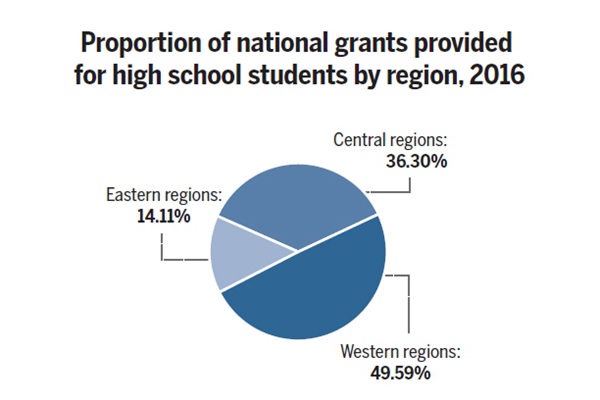
In 2016, a total of 4.98 million high school students received their schooling subsidies through national grants. Of these students, more than 2.47 million, or 32.21 percent, were in western China; about 1.82 million, or 19.74 percent, were in central China; and about 691,300 students, or 9.9 percent, were in eastern China.
The total amount of funding for national grants was 9.88 billion yuan. About 6.3 billion yuan, or 63.7 percent, came from the central government; 1.92 billion yuan, or 19.44 percent, came from provincial-level governments; 722 million yuan, or 7.3 percent, came from city-level governments; and 945 million yuan, or 9.56 percent, came from county-level governments.
By region, about 4.9 billion yuan, or 49.59 percent, went to western China; about 3.59 billion yuan, or 36.3 percent, went to central China; 1.39 billion yuan, or 14.11 percent, went to eastern China.
2) National tuition exemption
In 2016, more than 1.43 million high school students from impoverished families benefited from the tuition exemption policy.
Of these students, 878,500 were from western China, accounting for 11.44 percent of the total, about 427,400 were from central China, 4.64 percent of the total, and 131,800 were from eastern China, 1.89 percent of the total.
Total subsidies for supporting these high school students reached 924 million yuan, including 440 million yuan from the central budget, which accounted for 47.62 percent of the total.
By region, 522 million yuan of subsidies was spent in western China, accounting for 56.49 percent of the total; 278 million yuan was spent in central China, 30.1 percent of the total; and 124 million yuan was spent in eastern China, 13.42 percent of the total.
3) Aid from local governments
In 2016, in addition to implementing the national grants and tuition exemption policy, local governments also subsidized more than 4 million high school students.
Of these students, roughly 3.19 million were in western China, 631,600 were in central China and 187,400 were in eastern China.
In addition to implementing the national grants and tuition exemption policy, local governments provided nearly 4.41 billion yuan for student subsidies, of which 3.43 billion yuan went to western China, 721 million yuan went to central China and 258 million yuan went to eastern China.
4) School aid
In 2016, high schools themselves provided financial aid to 851,500 students. More than 383,000 students were in western China, 356,700 students were in central China and 111,500 were in eastern China.
The total sum spent by high schools was 930 million yuan, with 349 million yuan spent in western China, 426 million yuan spent in central China and 155 million yuan spent in eastern China.
5) Aid from society
In 2016, a total of 304,000 high school students received their schooling subsidies through social donations. Of these students, 159,200 were in western China, 88,100 were in central China and 56,700 were in eastern China.
The total sum of social donations to high school students was 607 million yuan, with 348 million yuan going to western China, 168 million yuan going to central China and 91 million yuan going to eastern China.
5.5 Financial aid for college and university students
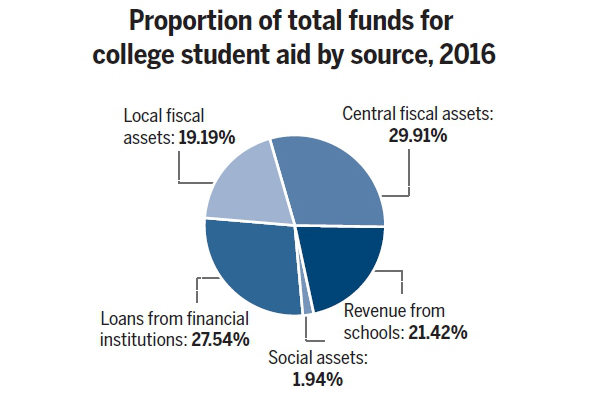
In 2016, financial aid for higher education from governments, communities and higher educational institutions totaled 95.58 billion yuan. More than 42.81 million students benefited from this financial aid.
More than 46.93 billion yuan came from government funding, accounting for 49.1 percent of the total in 2016. Central government funding totaled 28.59 billion yuan, accounting for 29.91 percent, and local government funding was 18.34 billion yuan, accounting for 19.19 percent.
Banks contributed 26.32 billion yuan to the national student loan program, accounting for 27.54 percent of the total aid package.
Universities and colleges spent 20.47 billion yuan of their revenues on providing financial support for students, accounting for 21.42 percent of the total aid package.
About 1.85 billion yuan, or 1.94 percent, came from social donations, including social entities, companies and individuals.
1) Scholarships
In 2016, 8.75 million students at colleges or universities benefited from national scholarships that totaled 21.02 billion yuan, accounting for 21.99 percent of the total aid package.
Of these students, more than 50,000 at junior colleges, colleges or universities received 400 million yuan of national scholarships; 35,000 postgraduate students received 700 million yuan; and 10,000 doctoral students received 300 million yuan.
More than 786,000 students at junior colleges, colleges or universities received national endeavor scholarships totaling 3.93 billion yuan.
About 1.32 million postgraduate students received a total of 9.33 billion yuan from academic excellence scholarships.
2) Grants
In 2016, more than 9.38 million students were supported by grants. The total sum spent on grants was 29.75 billion yuan, comprising 31.12 percent of the total. Of these students, more than 5.56 million at junior colleges, or universities received 15.76 billion yuan from national grants; 1.75 million postgraduate students received 10.99 billion yuan.
3) National student loans
About 3.78 million students received student loans totaling 26.32 billion yuan, accounting for 27.54 percent of financial aid for college and university students. Of these students, about 3.48 million received student credit loans from the region of their family’s permanent residence. The total sum was 24.19 billion yuan. National finance provided 2.64 billion yuan through national student loan programs to 4.13 million students.
4) Tuition and loan compensation for students and graduates enlisted in military service
A total of 124,100 enlisted students received 1.63 billion yuan in such compensation.
5) Tuition loan compensation for college graduates who work at grass-root levels
The compensation for such students was 566 million yuan, and nearly 500,000 students benefited from the compensation fund.
6) Free education and subsidies for students enrolled in teaching programs
About 62,200 students studying at six major normal universities and several local normal colleges and universities had their tuition exempted or waived. The total sum used for supporting normal college students was 544 million yuan.
7) Educational aid for retired soldiers
A total of 8,117 retired soldiers received financial aid to help them to study at colleges. Educational aid for this purpose totaled 44.59 million yuan.
8) College enrollment aid for freshmen
About 101 million yuan was spent on supporting 151,400 such students.
9) Allowances for graduate (teaching, research, administrative) assistantship positions
The compensation for such students totaled 4.54 billion yuan and around 1.65 million students benefited from this assistance.
10) Work-study
About 3.74 million students benefited from a total of 2.28 billion yuan through part-time jobs offered by schools.
11) Other forms of subsidies
About 1.19 billion yuan was given in allowances to help 1.68 million students who come from families suffering a range of hardships.
More than 1.56 billion yuan was allocated as food allowance to 6.72 million students.
About 190,000 students had their tuition fees waived. The total of waived tuition fees was 518 million yuan.
About 43,700 students benefited from interest-free loans. The total loan sum was 281 million yuan. About 2.34 million students benefited from other channels of assistance, with the total sum totaling 2.59 billion yuan.
In the autumn of 2016, nearly 1.2 million new students from impoverished families studying at junior colleges, colleges or universities benefited from the so-called “green channel” registration, accounting for 15.58 percent of all newly enrolled students.
The report is released by China National Center For Student Financial Aid.
